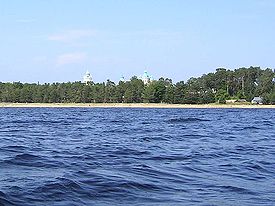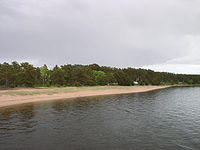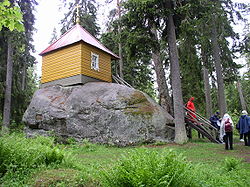
Konevets
Encyclopedia

Konevsky Monastery
Konevsky Monastery is a Russian Orthodox monastery that occupies Konevets Island in the western part of the Lake Ladoga, Leningrad Oblast, Russian Federation. It is often regarded as the twin monastery with the Valaam Monastery, also located on an island in the same lake.- Medieval origins...
. It is located off the southwestern shore of Lake Ladoga
Lake Ladoga
Lake Ladoga is a freshwater lake located in the Republic of Karelia and Leningrad Oblast in northwestern Russia, not far from Saint Petersburg. It is the largest lake in Europe, and the 14th largest lake by area in the world.-Geography:...
near the village of Vladimirovka. The island is part of the Priozersky District
Priozersky District
Priozersky District is a district of Leningrad Oblast, Russia. The area of the district is . Its administrative center is the town of Priozersk. District's population: -History:...
of Leningrad Oblast
Leningrad Oblast
Leningrad Oblast is a federal subject of Russia . It was established on August 1, 1927, although it was not until 1946 that the oblast's borders had been mostly settled in their present position...
. The nearest town is Priozersk
Priozersk
Priozersk is a town in Leningrad Oblast, Russia, centered on an island at the southwestern shore of Lake Ladoga, at the estuary of the northern armlet of River Vuoksi on the Karelian Isthmus. It is served by a station of the Saint Petersburg-Kuznechnoye railroad with the same name...
, which is located 40 km away from the island. The island of Valaam
Valaam
Valaam, also known historically by the Finnish name Valamo, is an archipelago in the northern portion of Lake Ladoga, lying within the Republic of Karelia, Russian Federation. The total area of its more than 50 islands is 36 km². The largest island is also called Valaam. It is best known as...
is 60 km away and St. Petersburg is 170 km away by boat. There is a ferry
Ferry
A ferry is a form of transportation, usually a boat, but sometimes a ship, used to carry primarily passengers, and sometimes vehicles and cargo as well, across a body of water. Most ferries operate on regular, frequent, return services...
link from Vladimirovka that makes the 6.5-km trip in 40–50 minutes.
Geography and environment

Lake Ladoga
Lake Ladoga is a freshwater lake located in the Republic of Karelia and Leningrad Oblast in northwestern Russia, not far from Saint Petersburg. It is the largest lake in Europe, and the 14th largest lake by area in the world.-Geography:...
was slightly less than 20 m above the current sea level, thus reaching the base of these cliffs, thousands of years before the Neva
Neva River
The Neva is a river in northwestern Russia flowing from Lake Ladoga through the western part of Leningrad Oblast to the Neva Bay of the Gulf of Finland. Despite its modest length , it is the third largest river in Europe in terms of average discharge .The Neva is the only river flowing from Lake...
emerged. The majority of the island is uninhabited, and covered by coniferous trees. The average annual temperature is 3.5°C. The island experiences a short summer season, from mid June to the latter half of August. July is the warmest month on the island. Winters can be quite harsh, and it is possible to walk to the island across the ice then.
History

Eastern Orthodox Church
The Orthodox Church, officially called the Orthodox Catholic Church and commonly referred to as the Eastern Orthodox Church, is the second largest Christian denomination in the world, with an estimated 300 million adherents mainly in the countries of Belarus, Bulgaria, Cyprus, Georgia, Greece,...
chapel
Chapel
A chapel is a building used by Christians as a place of fellowship and worship. It may be part of a larger structure or complex, such as a church, college, hospital, palace, prison or funeral home, located on board a military or commercial ship, or it may be an entirely free-standing building,...
has been built on top of it. The Russian name for the island, and thus the current Finnish name, are derived from the name of the rock or perhaps the assumed original Karelian name Hevossaari (Horse Island).
The island’s Orthodox Monastery of the Nativity of the Blessed Virgin Mary
Konevsky Monastery
Konevsky Monastery is a Russian Orthodox monastery that occupies Konevets Island in the western part of the Lake Ladoga, Leningrad Oblast, Russian Federation. It is often regarded as the twin monastery with the Valaam Monastery, also located on an island in the same lake.- Medieval origins...
was founded by Arseny of Novgorod in 1393. The Swedes captured the island and destroyed the monastery in 1577 and 1610. Sweden lost control of the island as a result of their being beaten by Peter I of Russia
Peter I of Russia
Peter the Great, Peter I or Pyotr Alexeyevich Romanov Dates indicated by the letters "O.S." are Old Style. All other dates in this article are New Style. ruled the Tsardom of Russia and later the Russian Empire from until his death, jointly ruling before 1696 with his half-brother, Ivan V...
in the Great Northern War
Great Northern War
The Great Northern War was a conflict in which a coalition led by the Tsardom of Russia successfully contested the supremacy of the Swedish Empire in northern Central Europe and Eastern Europe. The initial leaders of the anti-Swedish alliance were Peter I the Great of Russia, Frederick IV of...
. The current buildings are mainly from the 19th century and the beginning of the 20th century. The island did not suffer any damage in the Russian revolution
Russian Revolution of 1917
The Russian Revolution is the collective term for a series of revolutions in Russia in 1917, which destroyed the Tsarist autocracy and led to the creation of the Soviet Union. The Tsar was deposed and replaced by a provisional government in the first revolution of February 1917...
, as it had become part of Independent Finland in 1917.
In 1940, during the Second World War
World War II
World War II, or the Second World War , was a global conflict lasting from 1939 to 1945, involving most of the world's nations—including all of the great powers—eventually forming two opposing military alliances: the Allies and the Axis...
, the monks moved to the interior of Finland and ended up joining the monks at the Orthodox Monastery of New Valamo
New Valamo
New Valamo or New Valaam is an Orthodox monastery in Heinävesi, Finland. The monastery was established in 1940, when some 190 monks from Valaam Monastery in Karelia were evacuated from their old abode on a group of islands in Lake Laatokka to Eastern Finland...
. The island was ceded to the Soviet Union and the monastery fell into disrepair. From 1944 to 1990, the island was used by the military and thus closed to the public. In 1991, visitors were allowed back on the island and repairs and renovations to the monastery commenced. Approximately 20 monks now live on the island, which has become a popular place of pilgrimage.
Trivia
- The Finnish group Piirpauke recorded a song about the island entitled ’’Konevitsan kirkonkellot’’ (The Church Bells of Konevets) (Piirpauke I, Love Records LRCD 148, 1975).
External links
- Official website of the monastery (in Russia)

